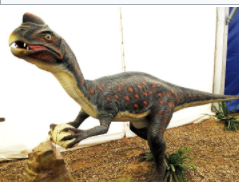One of the most intact dinosaur embryos ever discovered lies snuggled beneath the dimpled surface of the ancient egg, according to scientists in the journal iScience this week.
Scientists have discovered a perfectly preserved dinosaur embryo in the process of hatching from its egg, precisely like a chicken.

Tiny Dinosaur Fossil
The tiny dinosaur was coiled up so closely that its head was buried between its toes as if it was about to break loose from its shell. However, an unexplained occurrence buried the egg before the little creature drew its first breath, keeping the unhatched critter in what is now southern China for tens of millions of years.
According to experts, the embryo was discovered near Ganzhou, China, and is thought to be at least 66 million years old.
Baby Yingliang is a toothless theropod or oviraptorosaur that has been discovered. It is "the greatest dinosaur embryo ever unearthed in history," according to researcher Dr. Fion Waisum Ma.
70 Million Years Old Baby
The baby dinosaur was discovered in rocks that are thought to be around 70 million years old. However, its exact age is unknown.
The embryo is an oviraptorosaur, a genus of beaked therapod dinosaurs that existed between 130 million and 66 million years ago and are closely related to contemporary birds. Many of these organisms' characteristics are similar to those of their bird cousins, and the embryo even suggests one more: a curled pre-hatching stance.
Researchers now have a better grasp of the relationship between dinosaurs and current birds due to the discovery. The embryo was coiled in a position known as "tucking" in the fossil, a behavior found in birds just before hatching.
According to the AFP news agency, "this shows that similar behavior in contemporary birds initially evolved and started among their dinosaur forebears."
Egg Thief Lizards

Oviraptorosaurs, which means "egg thief lizards," were feathered dinosaurs that lived between 100 million and 66 million years ago in what is now Asia and North America during the Late Cretaceous era.
Magnificent Condition
Prof. Steve Brusatte, a member of the study team, said it was "one of the most magnificent dinosaur fossils" he had ever seen and that the embryo was about to hatch.
The Yingliang Stone Nature History Museum in China has a baby Yingliang 10.6in (27cm) long from head to tail and lies within a 6.7 inch-long egg.
The egg was discovered in 2000, but it was hidden for ten years.
Researchers turned their attention to the egg, which they assumed was harboring an embryo within, only after building work on the museum began and ancient fossils were being combed through.
The scientists will utilize sophisticated scanning techniques to visualize the dinosaur's whole skeleton because part of its body is still covered by rock.
For more prehistoric news, don't forget to follow Nature World News!
© 2025 NatureWorldNews.com All rights reserved. Do not reproduce without permission.





